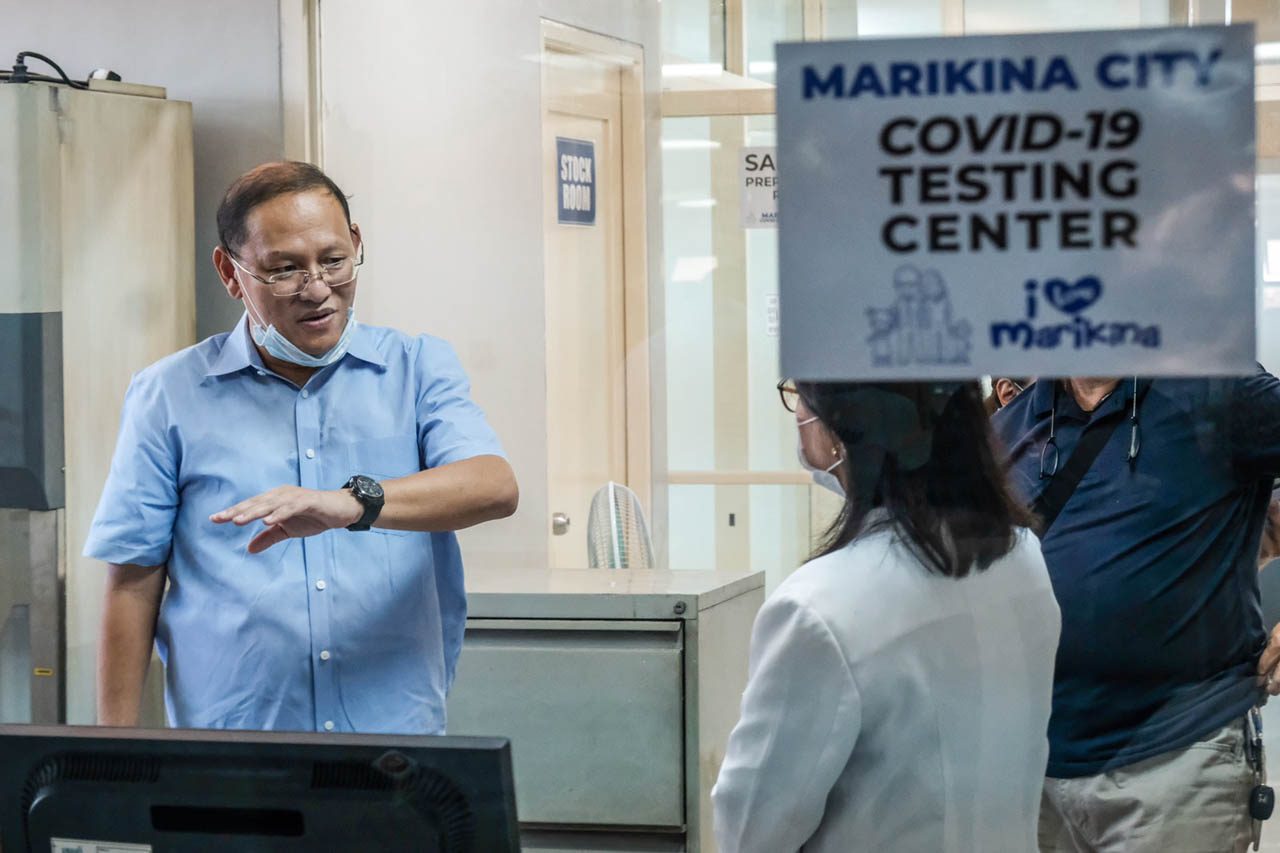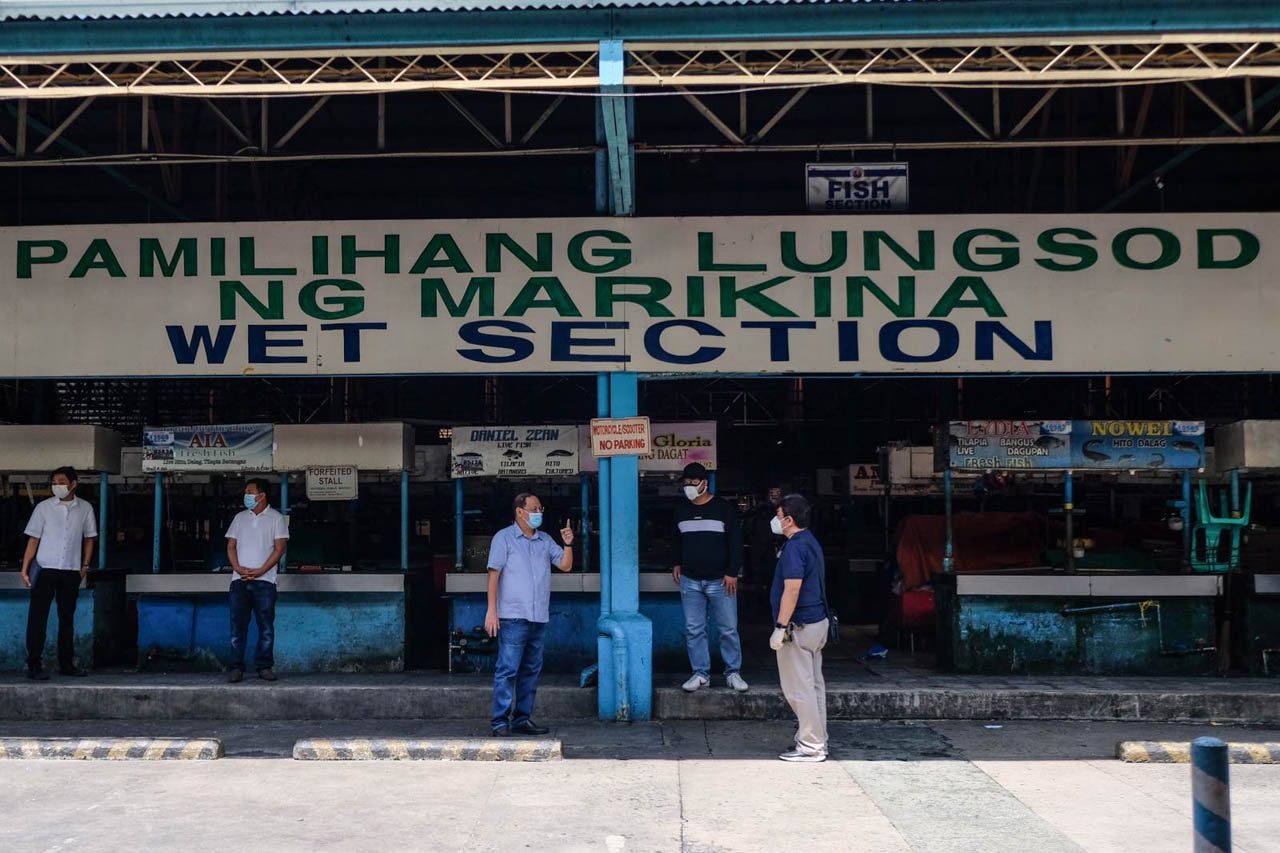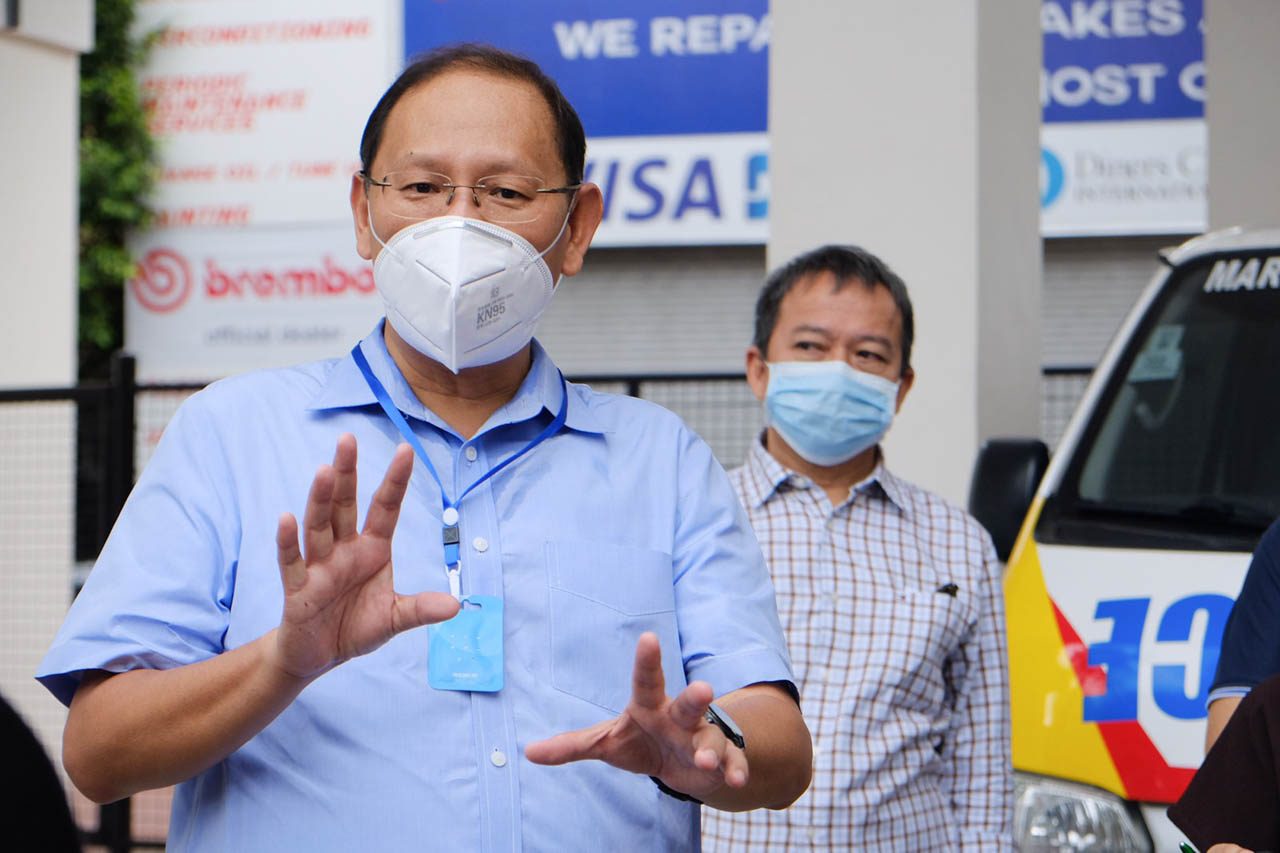SUMMARY
This is AI generated summarization, which may have errors. For context, always refer to the full article.

MANILA, Philippines – Marikina City Mayor Marcelino “Marcy” Teodoro never meant to be at loggerheads with the Department of Health (DOH).
All he wanted was to build a molecular diagnostic laboratory at the heart of the city so Marikina could test its own residents for the coronavirus. It was the logical thing to do when all health experts agreed mass testing was key in containing the pandemic.
This was in March, and Teodoro already predicted then that the Research Institute for Tropical Medicine (RITM) – the country’s primary testing facility – would soon be overwhelmed with the surging COVID-19 cases.
“So I simply followed that logic that we need to have the testing capacity. And how to have the testing capacity is to avoid dependency in terms of where to test, where we can avail of the testing,” Teodoro told Rappler. “I think what we should really exercise is common sense at this point in time.”
Yet the DOH would still drag its feet for almost a month in accrediting the Marikina Molecular Diagnostic Laboratory. Frustrated with red tape, Teodoro gave his ultimatum in the morning of April 14: accredit the lab or Marikina runs the facility without the DOH.
It forced the department to finally send a team to inspect Marikina’s testing lab. Six days later, DOH Secretary Francisco Duque III himself would describe the testing facility as “one of the best” in the country.
This lab became crucial in quelling the spread of COVID-19 in Marikina. It laid the foundation for much of what the city government is doing now to keep the virus at bay and help residents get back on their feet after weeks of lockdown.

As of Saturday, July 4, Marikina – a city of 450,000 residents – had recorded 169 active cases and 31 deaths out of the 382 confirmed cases it had recorded so far. The rest have recovered from the disease. Teodoro said it now takes 11.7 days for cases to double in Marikina, one of the slowest transmission rates for COVID-19 among Metro Manila cities.
Teodoro made the right call after all, but he refuses to take credit for it.
“Hanggang ngayon, ’di naman ako magaling na mayor talaga. Ang magaling ’yong taga-Marikina,” Teodoro said. “Dahil sinasabi ko sa mga taga-Marikina, lahat tayo may ownership, may stakehold. Kung ano man ang ginagawa ng pamahalaan ‘nyo, hindi pamahalaan ng mayor; pamahalaan natin ’to eh.”
(Until now, I wouldn’t say I’m an excellent mayor. It’s the people of Marikina who are excellent. I keep on telling Marikina residents that we all have an ownership here, we are all stakeholders. Whatever your government does, it’s not just the governance of the mayor; this is our government.)
The survival instincts of Mariqueños – one that residents have cultivated since Tropical Storm Ondoy ravaged the city 11 years ago – is their saving grace in the face of another and more formidable crisis.
The value of speed
Marikina is one of the first cities to conduct mass testing of residents, starting with those suspected to have COVID-19 and the vulnerable sectors like health workers, government employees, and returning overseas Filipino workers.
As quarantine measures were eased, Marikina’s testing coverage widened. Factory laborers of companies scheduled to resume operations in the city were tested. Jeepney and tricycle drivers were also checked for possible infection just before they were allowed to ply the roads again.
This has since become a regular health service in Marikina, which uses the rapid test as a screening tool in determining who undergoes the swab test.
Residents only wait up to 48 hours for their swab test results to come back. In most parts of the country, people have to wait in agony for days, even weeks, before they get their results.
Contact tracing in the city is also swift, with Marikina’s link map able to find the connection of each confirmed case to the very first patient who acquired COVID-19 in the city.
Case in point were the 66 vendors and helpers at the Marikina Public Market who were found to be “reactive” to COVID-19 when they were subjected to a rapid test. The succeeding swab tests showed only 29 of them actually had COVID-19, with most patients hailing from different areas outside the city like Antipolo, Cainta, and Pasig.
The numbers could have been worse, as goods sold in the decades-old Marikina Public Market are sourced across different provinces. Even non-Marikina residents buy from sellers there because of the low prices of products.
“Sabi nga sa akin ng isang nagtitinda sa palengke, ‘’Buti, Mayor, na-test agad.’ Sabi rin ng mga health experts, ’buti nakakapag-test tayo kaagad. Kung hindi, baka exponential ang dami,” Teodoro said.
(A market vendor told me, “It’s a good thing we were able to test them immediately, Mayor.” Health experts also told me the same thing. Otherwise, the numbers would have been exponential.)
Since then, the city government has imposed a number coding scheme in the market, where odd- and even-numbered stalls operate on different days to facilitate physical distancing.

Teodoro said he puts a premium on speed in testing and containment, as he hopes to lessen the time people need to spend under quarantine away from their families.
As early as March, the city government already turned the Marikina Hotel and Convention Center into a quarantine area for suspected cases. This was later augmented by 3 emergency quarantine facilities with a 120-bed capacity attached to the Amang Rodriguez Memorial Medical Center.
“At the earliest stage, they can be reunited with their families, unlike what is happening at this point na nagtatagal nang dalawang linggo, minsang isang buwan (that it would take two weeks, sometimes a month, before they could go home). I mean, the problem really with this COVID-19 is not only the medical condition, but the mental health also is suffering,” said the mayor.
Challenge of subsidies
Teodoro was also quick to give assistance to hundreds of workers who were displaced when Metro Manila was first placed under quarantine.
Under the local social amelioration program, shoemakers – Marikina is famous for its shoemaking industry – as well as residents who worked in the 4 malls in the city were among the sectors that received a one-time cash assistance and sacks of rice from city hall.
This was on top of the emergency subsidy program for poor households that was distributed by the Department of Social Welfare and Development (DSWD). It’s another point of frustration for Teodoro, however.
Because the DSWD based its list on the outdated 2015 census, less than half of the households the Marikina City government initially identified as beneficiaries received the cash aid.
The mayor recalled the difficulty of having to explain to people why the assistance promised to them would not be coming anytime soon.
“Our problem was that we had to explain to the communities that there were limited funds given to us. But we still distributed it, to help the families,” Teodoro said. “The problem is the pronouncement on the national level that everybody would have – solo parents, senior citizens, PWDs (persons with disabilities). So there was dissonance on the pronouncement and what we’re actually implementing on the ground.”
This prompted Teodoro to ask business establishments located in the city to provide aid to their workers if the companies could afford it.
Just recently, Marikina started operating its free transportation services to ferry workers around the city. But Teodoro knows this is still not enough, knowing that many residents need to travel outside the city to go to work. He believes localities need to come together if the country has any chance of beating the virus.
“It will have to cross borders. How could we best deal with COVID-19? It’s through cooperation among cities, I think, not only in terms of sharing data but, more importantly, to have a comprehensive, interconnected response,” Teodoro said. “It’s a whole-of-government approach really and a whole-of-community approach. The solution to the problem is system.”
Putting people first
A crucial aspect of Marikina’s response to the health crisis is Teodoro’s bid for residents to feel a sense of ownership of what the city is doing on the frontlines.
Barangay officials were tapped to augment the contact tracers from the city epidemiological and surveillance unit. They attended seminars to learn how to identify COVID-19 symptoms and the protocols on reporting infectious diseases.
Marikina also sought the help of homeowners’ associations to properly verify the poor households that needed to be prioritized for the emergency subsidy program.
Teodoro also makes it a point to reach out to his people directly. He dedicates one to two hours of each day to call positive cases still confined in hospitals and even frontliners on duty.
Teodoro recalled a time when a police officer almost cried when he received a call from the mayor just before the city government handed its cash assistance to Marikina cops.
“He almost cried while talking to me. [Sabi n’ya], ‘Mayor, thank you! ’Di ko ine-expect na tinawagan mo ’ko. Salamat, ha?’ Muntik ko na ngang ’di ’binigay ’yong assistance. Sabi ko, okay na pala siya,” Teodoro said with a laugh.
(He almost cried while talking to me. He said, “Mayor, thank you! I didn’t expect you would call me. Thank you.” I almost didn’t give him the assistance. I said he seemed okay already.)
The mayor also defended Marikina’s refusal to implement quarantine passes, saying he did not want to make residents feel they were being limited by the city government. Instead, authorities were ordered to be strict in imposing physical distancing protocols on the streets.
With no quarantine passes in the city, Teodoro observed that a different family member would go out to buy essential goods every week, which the mayor counts as a good thing.
“Isa kami sa isa may pinakamabilis na deceleration rate, pero wala kaming quarantine pass! So mukhang hindi doon sa quarantine pass talaga ang solusyon,” said Teodoro.
(We have one of the fastest deceleration rates, but we didn’t have a quarantine pass! So it seems quarantine passes aren’t the solution to the problem.)
Looking ahead
Four months since Marikina recorded its first COVID-19 case, the city is now shifting to adjust its programs for life after the pandemic.
Plans are underway to install a fiber optic network in Marikina, so residents, particularly students who now have no choice but to attend classes online, can enjoy fast and free internet access.
The city is in the process of buying tablets for public school students, with Mayor Teodoro himself checking the learning modules that will be distributed to the pupils.
Marikina is also working with the World Health Organization to build 4 “super health centers” around the city within the next two months. Each facility is eyed to have its own testing lab, specialty health services, and pharmacy.

The challenge, Teodoro said, has always been the same: build a robust and resilient health delivery system so the city can swiftly respond when COVID-19 cases rise.
There’s simply no room for complacency in Marikina. And if the worst is yet to come, Teodoro trusts Mariqueños would know the best way to wage the battle against the pandemic.
“We should, I think, listen to the people. They know what condition they are in,” Teodoro said. “They have their own stories, and I think we in government should be able to listen genuinely to what the people will say – what they feel, what they need, the solutions they think that would be necessary to address the problems that we have.” – Rappler.com
OTHER STORIES IN THE ‘PEOPLE VS PANDEMIC’ SERIES:
- In the fight vs COVID-19, these women mayors didn’t take chances
- Valenzuela City’s pandemic response: ‘Everything has to happen now’
- Legazpi City prepares a table for the quarantined
- In Baguio, Magalong returns as top investigator – for coronavirus contact tracing
- How Iloilo City became ‘Wakanda’ of the Philippines
- In Pasig, fighting corruption yields cash aid for the people
- How to fight the pandemic: Women mayors don’t sugarcoat how deadly the virus is
BOOKMARK THIS TO HAVE THE LINKS TO THE STORIES IN ONE PAGE:
Add a comment
How does this make you feel?
There are no comments yet. Add your comment to start the conversation.